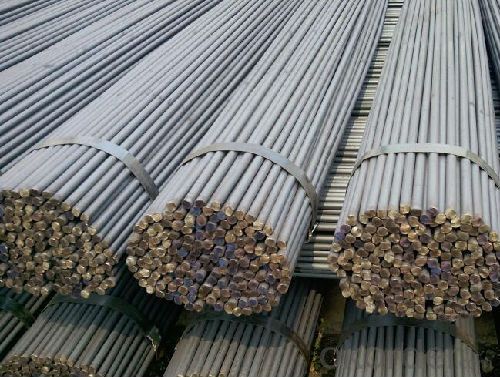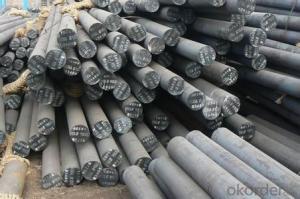Hot rolled steel round bar for construction
- Loading Port:
- Tianjin
- Payment Terms:
- TT or LC
- Min Order Qty:
- 25 m.t.
- Supply Capability:
- 100000 m.t./month
OKorder Service Pledge
OKorder Financial Service
You Might Also Like
Product Description:
OKorder is offering hot rolled steel round bar for construction at great prices with worldwide shipping. Our supplier is a world-class manufacturer of steel, with our products utilized the world over. OKorder annually supplies products to European, North American and Asian markets. We provide quotations within 24 hours of receiving an inquiry and guarantee competitive prices.
Product Applications:
Hot rolled steel round bar are ideal for structural applications and are widely used in the construction of buildings and bridges, and the manufacturing, petrochemical, and transportation industries.
Product Advantages:
OKorder's steel round bar are durable, strong, and resist corrosion.
Main Product Features:
· Premium quality
· Prompt delivery & seaworthy packing (30 days after receiving deposit)
· Corrosion resistance
· Can be recycled and reused
· Mill test certification
· Professional Service
· Competitive pricing
Product Specifications:
1. Grade: Q235, A36, SS400, S235JR
2. Feature: Unbreakable, grinding resistant and high impact value
3. Diameter: 8mm-150mm
4. Performance: Mainly for civil construction
5. Characteristics: Even hardness, no deformation, no breaking, no mal-roundness
6. Technique: Hot rolled
7. Mass: Mass (kg/m) = Diameter (mm) × Diameter (mm) × 0.00617
Usage and Applications of Steel Round Bar Products
1. Steel round bar products is used in construction and a large number of architectural and engineering structures. And it can be used in production of handrail, windows, machinery, telecom and curtain wall.
2. It can be used in the fields like metal mines, cement plants, water coal slurry, power stations and chemical industry.
3. Besides, we can supply some especial material steel round bar that can be used for main shaft of steamer, hummer shank, with big section and supper force.
4. Recommended watchcase factory, screw factory and other cold stamping products industry use.
Packaging & Delivery of Steel Round Bar Products
Packaging Detail: All goods are packed in bundle with steel strips and shipped by break bulk vessel or container (depend on target market and different ports)
Delivery Detail: 45 days
Trade terms: FOB, CFR, CIF
MOQ: 25 tons per specification; we can negotiate the quantity if the specification is normal or we have stock of one specification.
Weight: The price invoicing on theoretical weight basis or actual weight basis depends on customer’s request.
Shipment: The shipment of bulk break or container is depends on customer’s request and the situation of the port of destination.
Documents given: Full set of original clean on board bill of lading; Original signed commercial invoice; Original packing list; Policy of insurance; Certificate of origin and what the target market needs.
Production Flow of Steel Round Bar Products
Material prepare (billet) — heat up — rough rolling — precision rolling — cooling — packing — storage and transportation
Characteristics of Steel Round Bar Products
1. The steel in which the main interstitial alloying constituent is carbon in the range of 0.12–2.0%.
2. As the carbon percentage content rises, steel has the ability to become harder and stronger through heat treating; however it becomes less ductile.
3. Regardless of the heat treatment, higher carbon content reduces weld ability. In carbon steels, the higher carbon content lowers the melting point.
4. Quality should be in conformity with the specification of the manufacturer. Quantity and packing conditions should be in conformity with the term in the contract.
FAQ:
Q1: What makes stainless steel stainless?
A1: Stainless steel must contain at least 10.5 % chromium. It is this element that reacts with the oxygen in the air to form a complex chrome-oxide surface layer that is invisible but strong enough to prevent further oxygen from "staining" (rusting) the surface. Higher levels of chromium and the addition of other alloying elements such as nickel and molybdenum enhance this surface layer and improve the corrosion resistance of the stainless material.
Q2: Can stainless steel rust?
A2: Stainless does not "rust" as you think of regular steel rusting with a red oxide on the surface that flakes off. If you see red rust it is probably due to some iron particles that have contaminated the surface of the stainless steel and it is these iron particles that are rusting. Look at the source of the rusting and see if you can remove it from the surface.



- Q: Can steel round bars be used for making punches and dies?
- Yes, steel round bars can be used for making punches and dies. Steel round bars are commonly used in tool and die making due to their strength, durability, and versatility. They can be machined and formed into various shapes and sizes to create punches and dies that can withstand the high forces and pressures involved in metalworking and material forming processes.
- Q: What is the maximum aluminum content allowed for steel round bars?
- The aluminum content permissible for steel round bars fluctuates based on the particular steel grade and industry norms. Generally, the aluminum content in steel round bars is commonly restricted to a maximum range of 0.03-0.06% for the majority of commercial and structural steel grades. Nevertheless, certain specialized steel grades, particularly those employed in the aerospace sector, may permit higher levels of aluminum content. It is crucial to refer to the technical specifications or industry norms of the specific steel grade to ascertain the maximum permissible aluminum content for steel round bars.
- Q: Q235 and mechanical properties of hot rolled steel cold drawn steel have what difference, Q235 hot rolled steel with 12 combined shearing machine has a number of very hard, the damage of the blades, why
- First of all, Q235 refers to the yield strength, is a heat treatment method, commonly used in thin steel plate material,
- Q: What are the different types of steel round bars available in the market?
- There are several different types of steel round bars available in the market, each with its own unique characteristics and applications. Some of the most common types include: 1. Mild Steel Round Bars: These are the most commonly used type of steel round bars due to their versatility and affordability. They have a low carbon content and are easy to weld and machine, making them suitable for a wide range of applications. 2. Carbon Steel Round Bars: Carbon steel round bars have a higher carbon content than mild steel, which gives them increased strength and hardness. They are commonly used in applications that require high strength, such as construction and machinery manufacturing. 3. Alloy Steel Round Bars: Alloy steel round bars are made by adding various alloying elements, such as chromium, nickel, or molybdenum, to improve their mechanical properties. These bars offer enhanced strength, toughness, and resistance to wear and corrosion, making them ideal for applications in the aerospace, automotive, and oil and gas industries. 4. Stainless Steel Round Bars: Stainless steel round bars are highly corrosion-resistant due to the presence of chromium, which forms a protective oxide layer on the surface. They are widely used in industries such as food processing, pharmaceuticals, and chemical processing, where resistance to corrosion and hygiene are crucial. 5. Tool Steel Round Bars: Tool steel round bars are specifically designed for tooling applications, such as cutting, drilling, and shaping materials. They have high hardness, wear resistance, and heat resistance, making them suitable for manufacturing tools and dies. 6. Duplex Steel Round Bars: Duplex steel round bars are a type of stainless steel that contains both austenitic and ferritic microstructures. They offer a combination of high strength, excellent corrosion resistance, and good weldability, making them ideal for applications in the chemical and petrochemical industries. These are just a few examples of the different types of steel round bars available in the market. The choice of the right type depends on the specific requirements of the application, including strength, corrosion resistance, machinability, and cost.
- Q: What is the minimum tensile strength of steel round bars?
- The minimum tensile strength of steel round bars can vary depending on the specific grade of steel being used. However, in general, most steel round bars have a minimum tensile strength of around 400 megapascals (MPa) or 58,000 pounds per square inch (psi). It is important to note that this is a baseline minimum and different grades of steel may have higher tensile strengths to suit specific applications or requirements.
- Q: Can steel round bars be used in the production of couplings?
- Yes, steel round bars can be used in the production of couplings. Steel round bars are commonly used in various industrial applications due to their strength, durability, and versatility. When it comes to producing couplings, steel round bars provide the necessary structural integrity and reliability required for such components. They can be machined, forged, or shaped to meet specific coupling designs and requirements. Furthermore, steel round bars offer excellent resistance to corrosion, which is crucial for ensuring the longevity and functionality of couplings in different environments. Overall, steel round bars are a suitable material choice for the production of couplings, providing the necessary strength and durability needed for efficient and reliable coupling operations.
- Q: Can steel round bars be used for making axles?
- Yes, steel round bars can be used for making axles. Steel is a strong and durable material that is commonly used for axles due to its high tensile strength and ability to withstand heavy loads and stress. Round bars provide a suitable shape for axles as they offer good structural integrity and can be easily machined and manipulated to meet specific axle requirements.
- Q: Are steel round bars suitable for bicycle frame applications?
- Yes, steel round bars are suitable for bicycle frame applications. Steel is a popular material choice for bicycle frames due to its strength, durability, and versatility. Steel round bars provide excellent structural integrity, making them ideal for supporting the weight and stress placed on a bicycle frame during use. Additionally, steel is known for its high fatigue resistance, which means it can withstand repeated loading and unloading without losing its strength. Steel round bars also offer good weldability, allowing for easy construction and repair of bicycle frames. Overall, steel round bars are a reliable and practical choice for bicycle frame applications.
- Q: Can steel round bars be used for making control arms?
- Control arms, which are crucial elements of a vehicle's suspension system, necessitate the utilization of steel round bars. These bars serve as the link between the chassis and the wheel hub, enduring considerable forces like torsion, bending, and compression. Particularly, steel round bars made from high-strength steel alloys possess exceptional mechanical attributes, including high tensile strength, good ductility, and high fatigue resistance, rendering them suitable for control arm applications. Furthermore, the machinability and weldability of steel round bars facilitate the creation of intricate and precise control arm designs. However, it is imperative to ensure that the chosen steel round bars adhere to the required specifications and standards for control arm fabrication, encompassing dimensional accuracy, material composition, and quality control.
- Q: What are the tolerances for steel round bars?
- The tolerances for steel round bars typically depend on the specific industry standards and customer requirements. However, common tolerances for steel round bars include variations in diameter, straightness, length, and surface finish. These tolerances ensure that the steel round bars meet the desired specifications and can be effectively used in various applications.
Send your message to us
Hot rolled steel round bar for construction
- Loading Port:
- Tianjin
- Payment Terms:
- TT or LC
- Min Order Qty:
- 25 m.t.
- Supply Capability:
- 100000 m.t./month
OKorder Service Pledge
OKorder Financial Service
Similar products
Hot products
Hot Searches
Related keywords




























